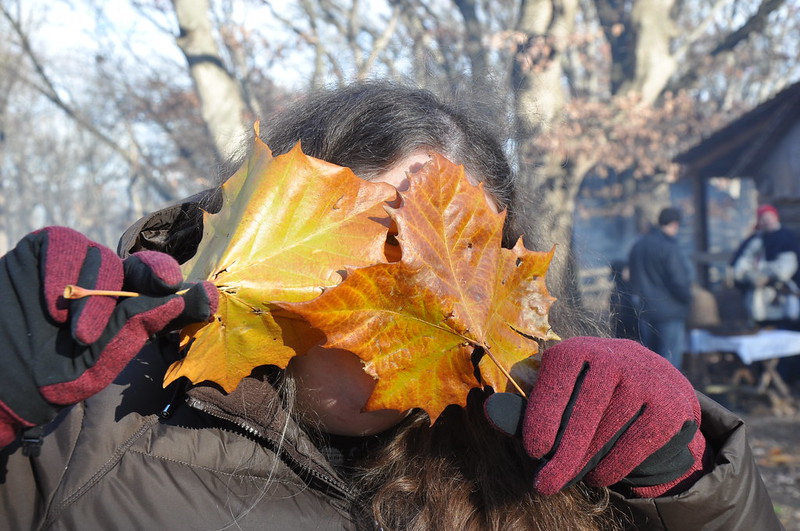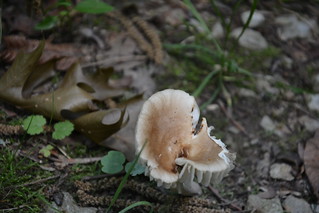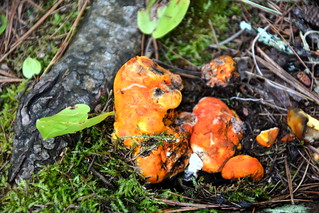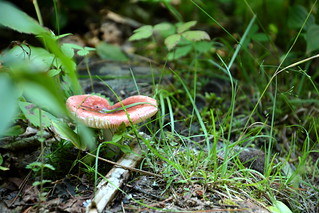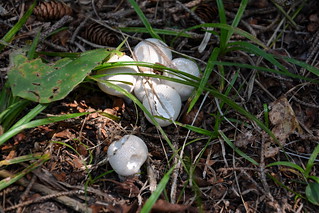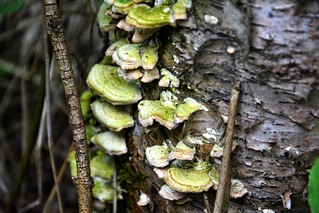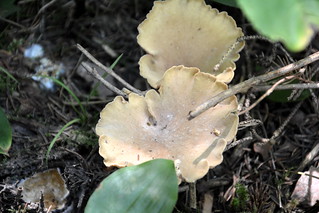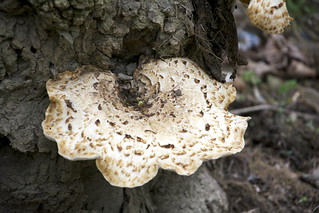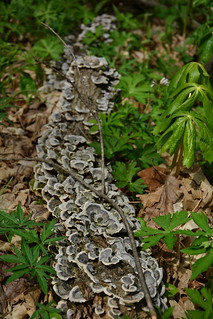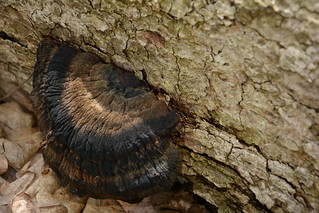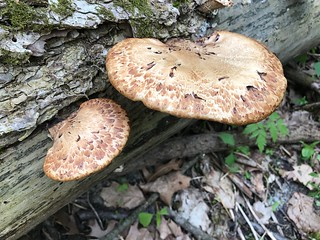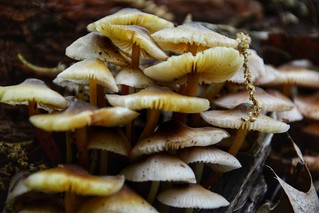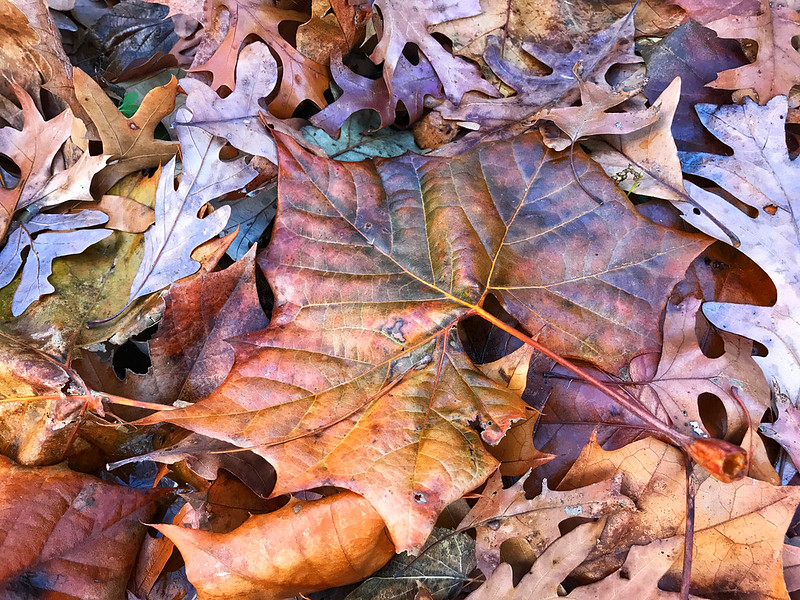Tag Archives: forest preserves
Dragonflies and ice cream
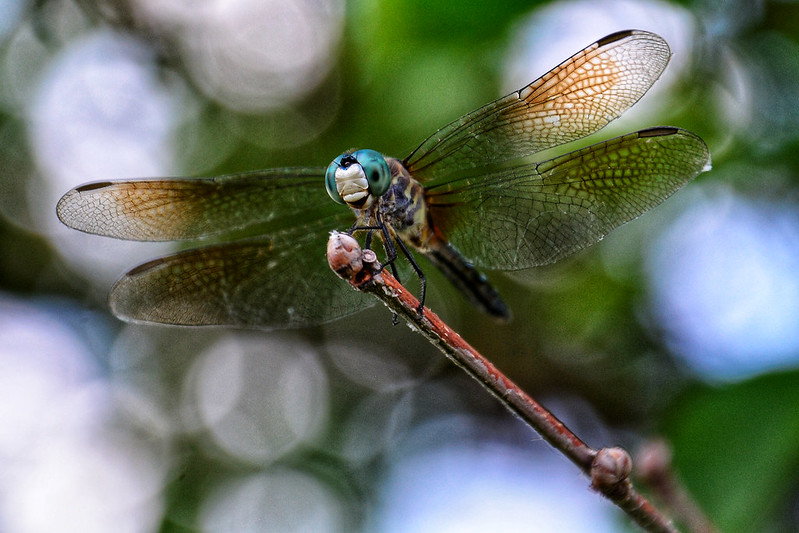
I told J this Will County Forest Preserve District program at Monee Reservoir sounded crunchy; I don’t think he quite got it.
I met him at the University Park Metra station, which is not that far north from Monee. For me, it was brutally sunny and hot, but at least I made it through the first part of the program. I had to pass on the second half, a jaunt to another bridge that wasn’t even that far away. At the first, the kids found enough dragonfly and damselfly larvae and other pond critters to keep them engaged for an hour or more, and I wandered off to see what was on the other side (dragonflies, damselflies, butterflies, one elusive Hemaris thysbe moth).
Despite my dropping out partway through, the leader was kind enough to give us ice cream sandwiches. He spent a lot of time answering my questions and showing me illustrative photos. By the time we left the building, where the air conditioning had failed a couple of days earlier, clouds had gathered and the temperature had dropped.
Monee’s not a big town but we found a great cheese and fruit plate, beer, and a light dinner at Labas Latte & Vino. And so back to reality . . . but at least I don’t have to live on 300 mosquitoes an hour.
Camp Bullfrog Lake, springtime edition
Having survived an autumn visit to Camp Bullfrog Lake, and being fond of the Palos area for its hills, moraines, sloughs, woods, and forest preserves, I wanted to plan another stay. There are only two large cabins, and I was happy to get one of them for May, which I had figured would be at the height of fine spring weather. HA.
May 18, 2019
The adventure began in Homewood, where I met J. He was immediately distracted by an Operation Lifesaver “train” blowing its horn as it circled downtown Homewood. It looked popular and crowded, or we might have ended up angling for a ride.
Our first stop was at Cottage on Dixie, where, unbeknownst to us, we were about to have our last meal there. A month later the owner announced it was closing. A few days after that, the owner announced a grand reopening on July 18. My head spins, and I’m guessing it wasn’t the last Cottage meal after all.
We settled in briefly at Camp Bullfrog Lake, then set out for sandwiches at Ashbary House at the Old Willow Shopping Center, set against a wooded hillside. I love the way it looks.

Back at camp, a full moon (well, a few hours past) rose above the lake into the clouds, looking a bit like Saturn. The clouds and moon over the lake were the perfect complement to the campfire. Our fire-starting skills are better if still in need of improvement. A bucket of topnotch fire starter didn’t hurt, and with close nursing our fire flamed merrily for several hours and marshmallows. The full moon was an unexpected bonus. (Usually I pay closer attention to moon phases.)
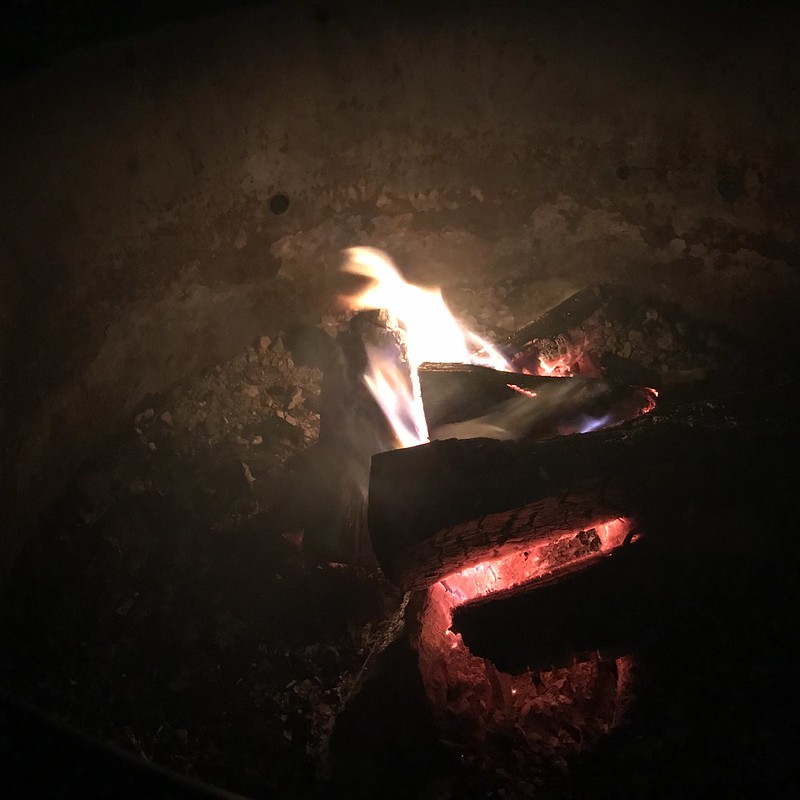
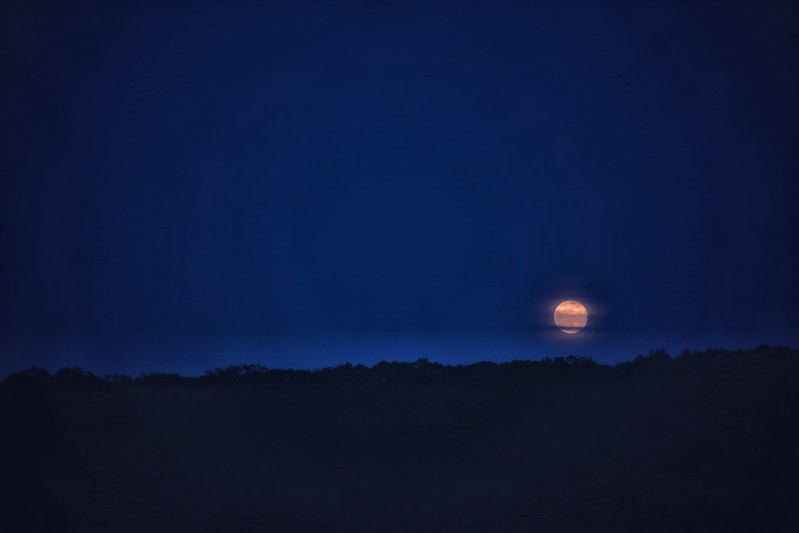
May 19, 2019
The morning looked promising weather wise.
I found we had a lot of neighbors at the next cabin, with breakfast piled high atop their picnic table. One of their cars had Alaska plates. I marveled that anyone would drive from anywhere in Alaska to Illinois. I might never have gotten past, say, Montana or Wyoming.
After breakfast at Maple-N-Jams, we happened upon the Nut House in Bridgeview. I gained weight looking at the colorful displays, but managed to walk away with mostly seeds.

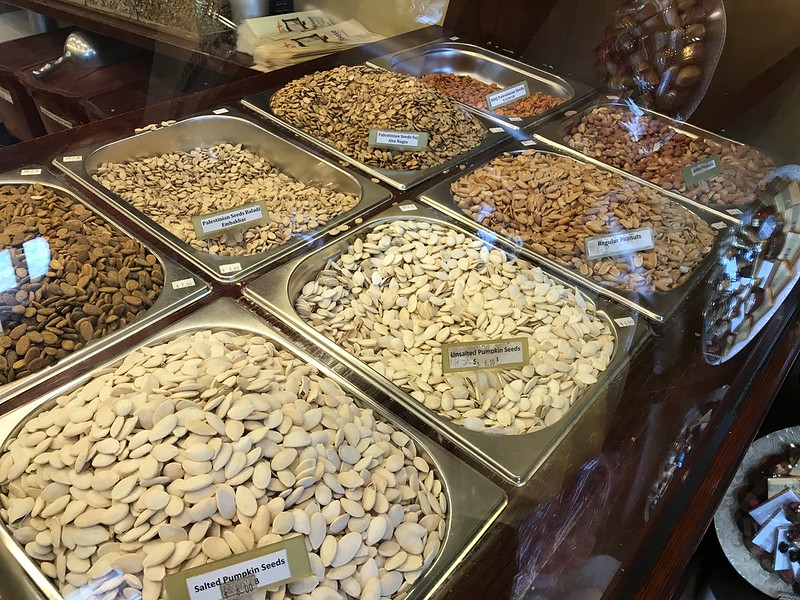
Upon returning to camp, we found the perfect excuse to skim old travel magazines and, in my case, read more about The Black Death — a lengthy downpour. Undoubtedly payback for the serendipity of the full moon.

With numerous sloughs and the Des Plaines River, Chicago Sanitary and Ship Canal, and Cal-Sag Channel running parallel to each other through this area, there are plenty of steel truss bridges. I love them. I wonder if the blue paint on some is relatively new to dress them up.


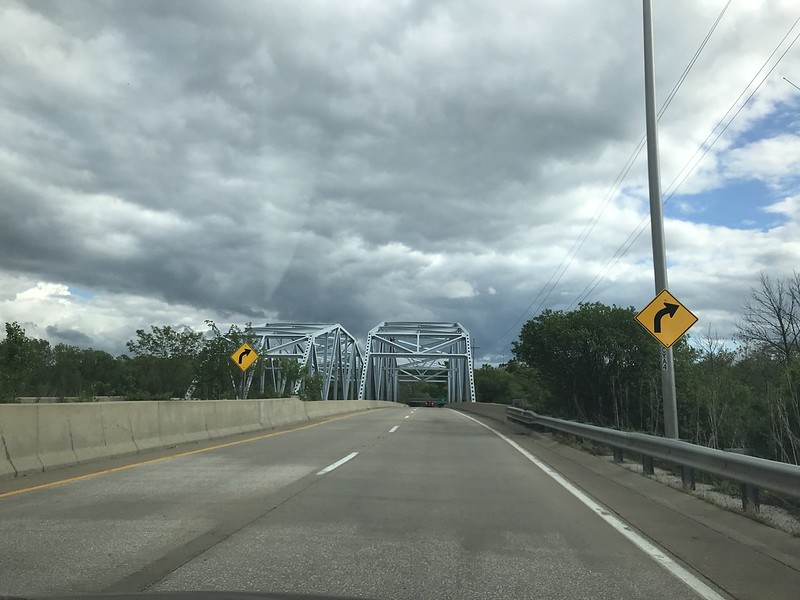
I thought we might see a lot of flowers in bloom at Little Red Schoolhouse, but maybe mid to late May was too late. Instead we found one of the ponds full of tadpoles, two northern water snakes, and a green heron trying to be still and invisible. Suddenly, it took off after another green heron we hadn’t noticed across the way. A brief yet epic battle ensued, and in the end I couldn’t tell which one hightailed it to the woods and which took over pond patrol.



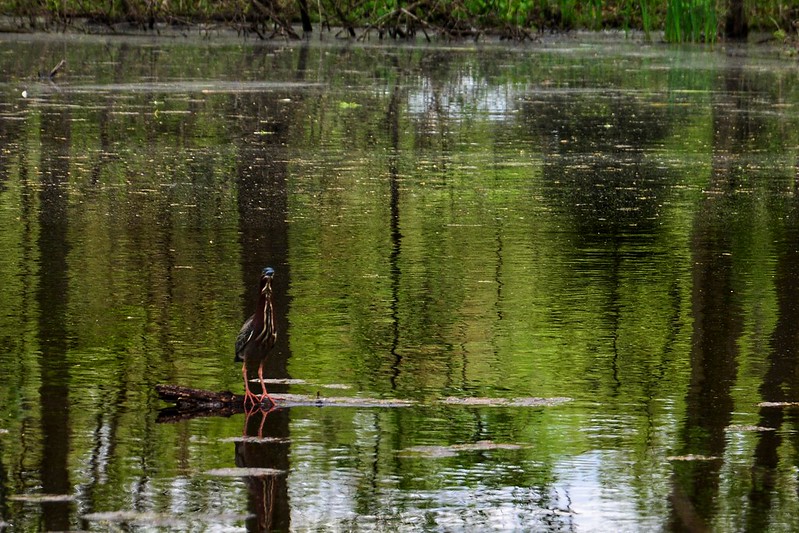
On the other side, the great blue herons and great egrets of Longjohn Slough kept a watchful eye on each other, like boxers in their respective corners between rounds.
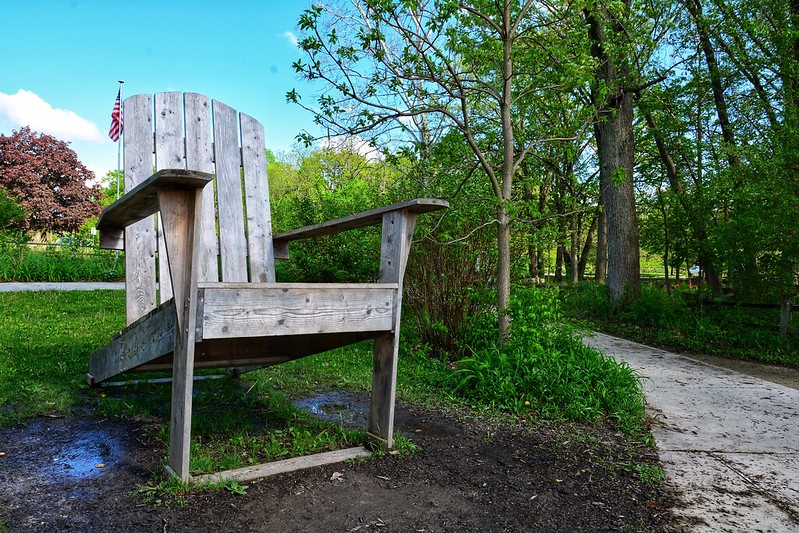
At Little Red Schoolhouse we’d seen a flier for a mushroom/fungus walk at Swallow Cliff Woods. We decided to investigate on our own. We didn’t get far down the trail before my pain levels rose and my energy levels flagged, just far enough to this tantalizing pathway. Someday.
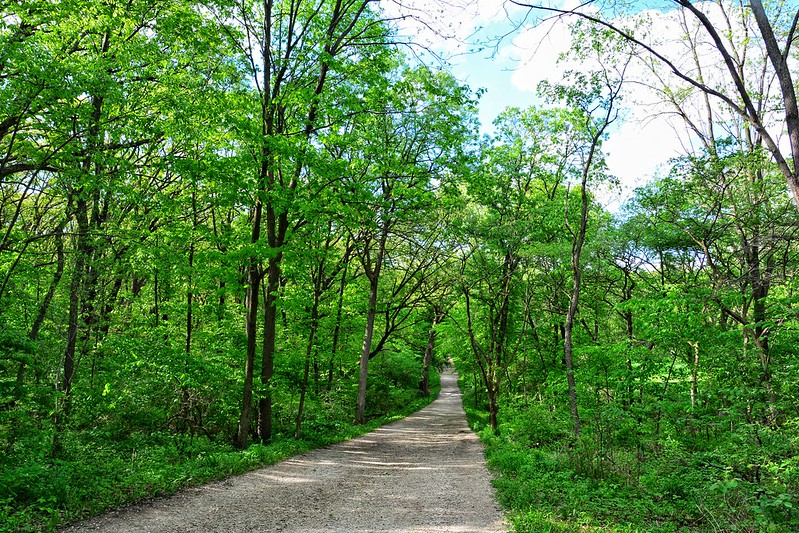
I hadn’t noticed any mushrooms in the short distance we’d walked, but on the return trip we both noticed several (not the same ones in all cases). J is credited with the find of the day, a magnificent morel. I don’t think I’ve seen one “in the wild.” I began to understand why the naturalists had chosen Swallow Cliff Woods for their fungus walk. Now if only I could find (or recognize) slime molds in any form . . .

For dinner we headed to Jen’s Guesthouse, formerly Courtright’s. It was too wet to sit outside in the garden area against the wooded hillside, but the inside isn’t shabby.

Back at camp, we still hadn’t perfected the art of fire making but finally had enough going to toast marshmallows. When we were sure we’d had enough, we tossed in the Mystical Fire. I found out later we should have used three packs, but even one was . . . mystical. Or at least colorful.
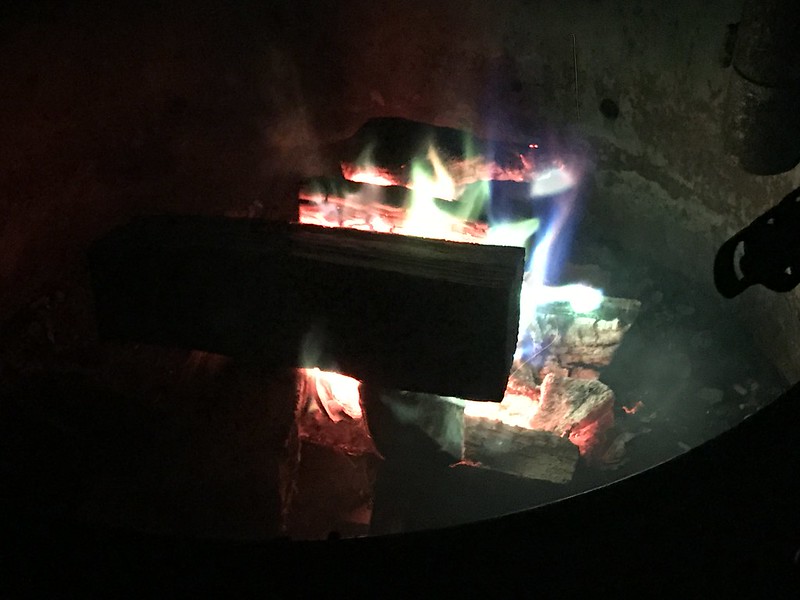

May 20, 2019
We went to Lotus Cafe, which turned out to be part of Pete’s Fresh Market, and ended up with a breakfast-by-weight buffet. We also stopped at Strange Brew Cafe, which I recognized from last year.
Back at Camp Bullfrog Lake, we packed and took a last walk around. When I approached the pier, I was startled by a great blue heron perched on the railing, no doubt keeping an eye out for fresh lake fish (or even the eponymous bullfrogs). Just when I thought it was going to let me get close, it slowly flapped off to shore. They like to keep their distance. I don’t blame them.
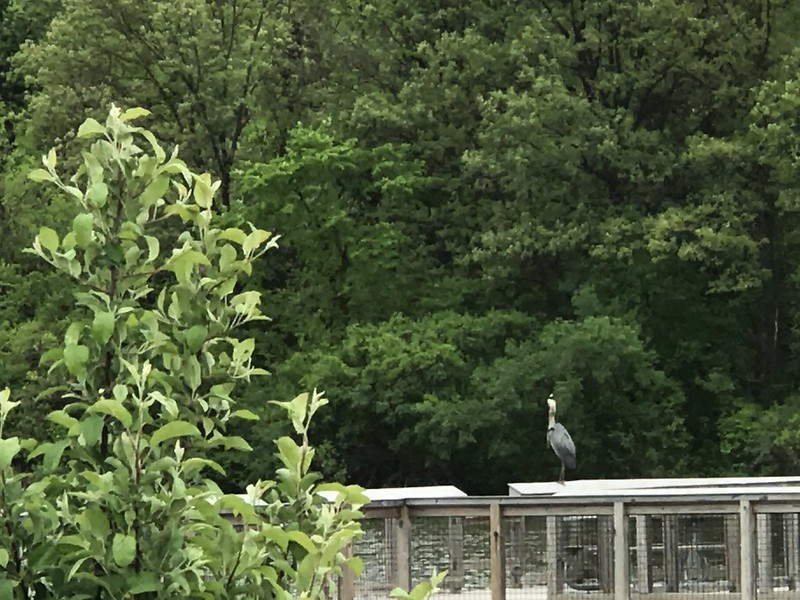
While driving around we kept passing a historical marker sign and decided to investigate. This led us to St. James at Sag Bridge Church and Cemetery, which involved some steep hills. I can’t say for certain we found the historical marker, but i did spend a few moments checking out Our Lady of the Forest. It turns out the church is on the National Register of Historic Places. I’m reminded too that I want to read The Mystery at Sag Bridge by local writer Pat Camalliere, whom I’d met briefly at Settlers’ Day at Sand Ridge Nature Center in South Holland.





Despite the I-355 extension and the encroaching warehouse-type developments, I’m still charmed by most of Bluff Road in Lemont. We stopped at Black Partridge Woods, walked along the picnic shelter side of the stream for a bit, then returned to the parking lot to find two male scarlet tanagers paying court — presumably — to a female. I don’t get to see these birds very often, so it was a treat and a thrill worth the entire trip — downpours, damp, and all.


We made another visit to Little Red Schoolhouse Nature Center. While no green heron lurked about that I could see, the great blue herons and great egrets were still skirmishing along Longjohn Slough.


For a light dinner we stopped at Spring Forest 2, where I love the terraced outdoor seating areas.

Finally for dessert, we headed to the Plush House to enjoy ice cream from the comfort of an Adirondack chair. And so ended another weekend adventure in one of Illinois’ more interesting areas.

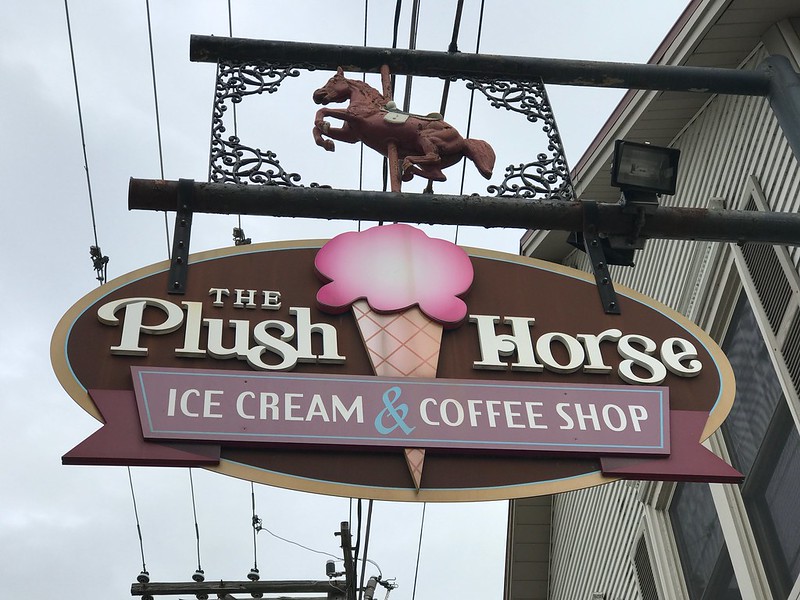
Mushrooms and fungi
Throes of autumn seen in a sycamore leaf
Oh, deer at Eggers Grove
14 October 2018
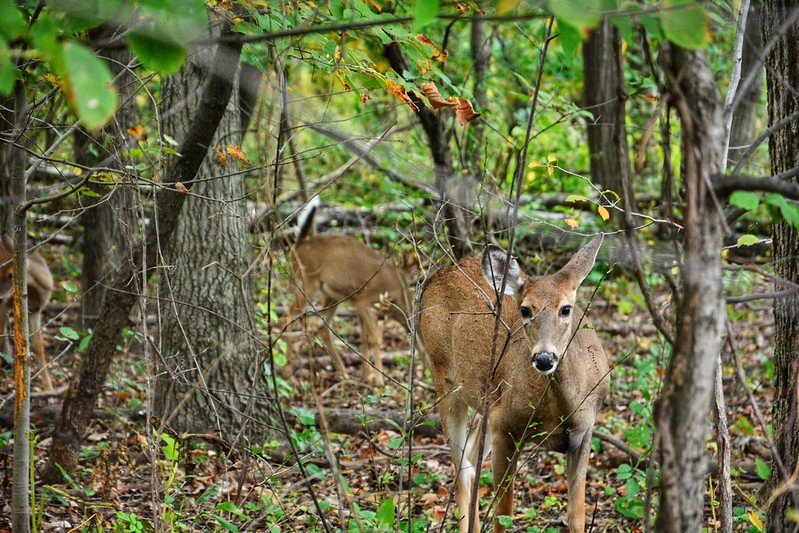
While returning from a walk on the “ancient dunes” trail at Eggers Woods, one of the Forest Preserves of Cook County that’s almost in Indiana, I spotted this doe and two three-quarters grown fawns on and to the side of the trail a short distance from the parking lot. They have lots of room to roam at this park a few blocks from I-90, but friend J and I saw at least five to six deer near the trail and/or lot. While this looks like a challenging stance and she kept an eye on us, she didn’t seem inclined to scare easily. They’re used to hikers without guns, I suppose. Some of the deer seemed thin to me, which isn’t good for them with winter around the calendar corner.
Camp Bullfrog Lake
October 6, 2018
It’s not easy to reserve a large cabin at one of the Forest Preserve District of Cook County campgrounds, which became very popular very quickly. I managed to book one at Camp Bullfrog Lake in the Palos Hills region of southwest Cook County. The “hills” are moraines where the leading edge of a glacier halted and material at the leading edge piled up. With hills, woods, rivers, and sloughs, and the only canyon in the county (tiny Sagawau), this is one of the more interesting areas within reach of Chicago.
Camp Bullfrog Lake lies across 95th Street from Maple Lake, which is popular with boaters and fishers. Boats and kayaks are also available for rent at the campground, where we watched two men and a tiny figure paddling away.
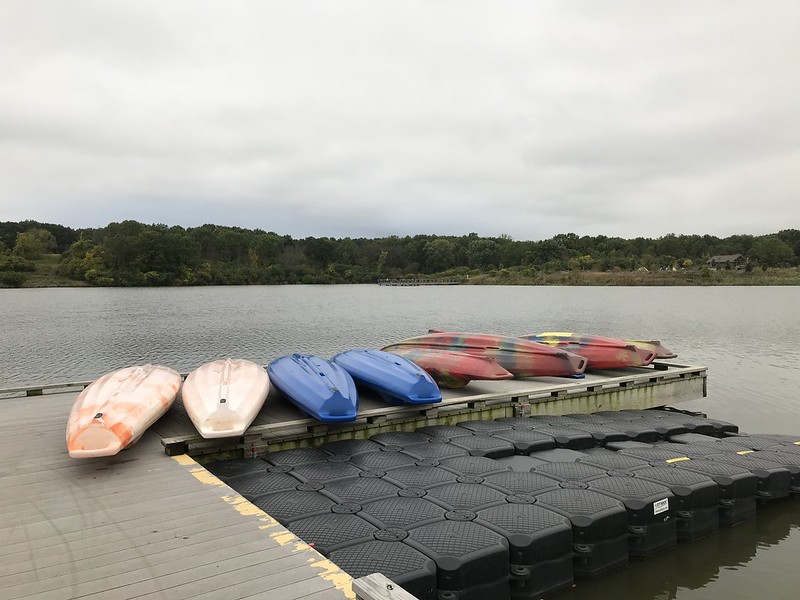
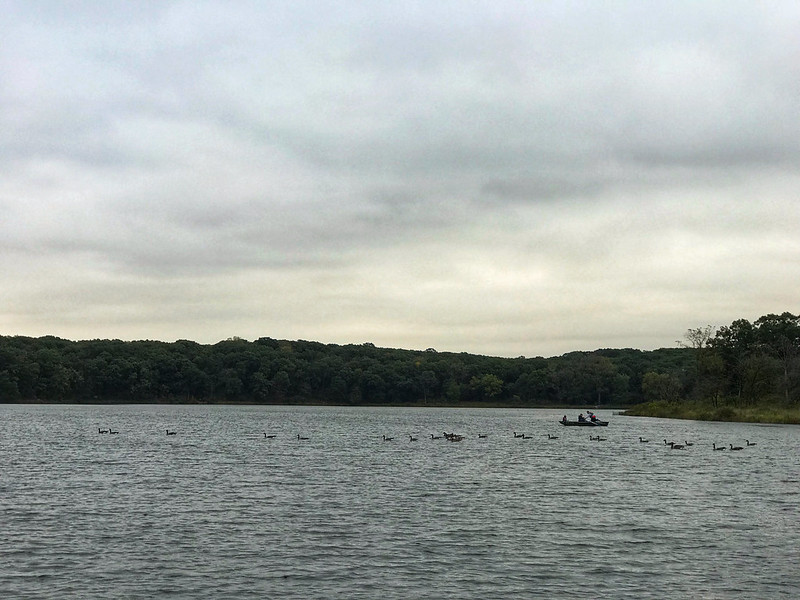
The campground lay under heavy, low cloud cover, but the grim sky didn’t deter one group of revelers from playing cricket in the roadway. We passed them on our way out to procure what I consider to be a camping essential for amateurs — firestarter. (We already had our complimentary bundle of wood from the 24-hour office/store.)
For dinner we stopped at the Irish Legend on Archer Avenue, which I didn’t recognize but had been to once before in January 2013. Nearby, Jen’s Guesthouse (not a B&B) has taken over the space formerly inhabited by Courtright’s, which I do remember visiting a long time ago. It was a fine dining restaurant set against a wooded hillside. I loved it.
Back at Camp Bullfrog Lake we struggled to get a fire going. Eventually it caught, then died down several times only to flare up again on its own (zombie campfire?). With so much anxiety over keeping the fire going, s’mores were too much effort, but we burned, er, toasted more marshmallows than is healthy.
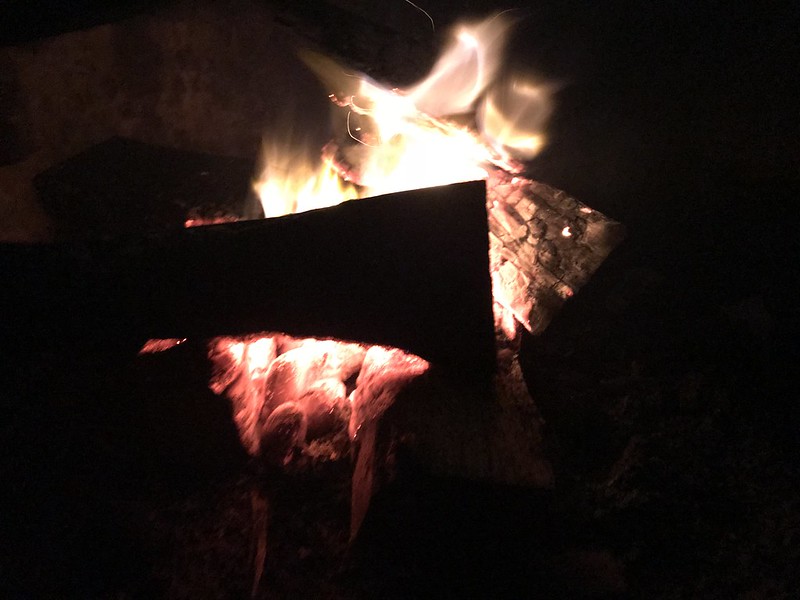
To the east (although I didn’t know the direction at the time) a glow in the sky might have appeared to be a lingering sunset on a less cloudy day, but likely was light pollution, source unknown (Chicago Ridge Mall?). As the campfire burned and reignited, stars began to appear, mostly overhead and to the west. At some point it dawned on me that gaps must have opened in the oppressive cloud cover of the day.
October 7, 2018


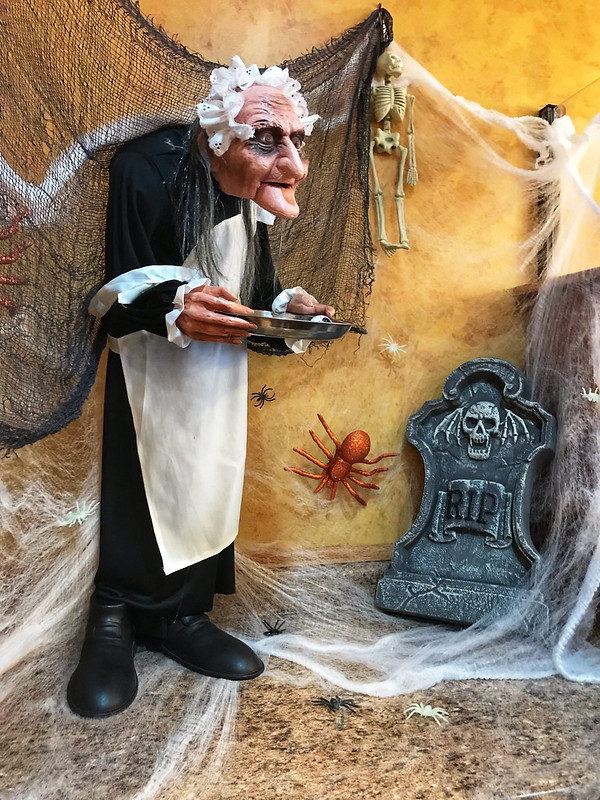
After the evening sugar high, next morning we went to Maple -N- Jams Café, a small storefront restaurant with a big menu and a wait. You can’t go wrong with a name like Maple -N- Jams (except grammatically).
Next we stopped at Strange Brew Café.
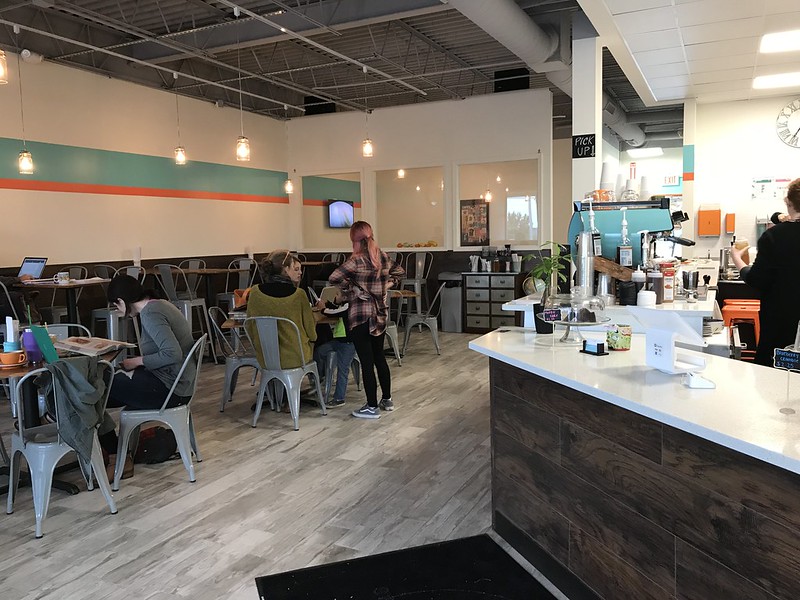
As it turned out, our visit to the area coincided with the 53rd annual arts and crafts fair at Little Red Schoolhouse Nature Center. You can judge an event’s popularity by the number of LEOs required to direct traffic. We were sent around the corner, so to speak, to the Pioneer Woods parking lot, where we caught one of the circulating school buses hired to shuttle folks back and forth. I must note that school buses today have a lot less leg room than they did in, say, 1976.
When we arrived at last we found artists spread out in and around the schoolhouse and the nature center, along with folk musicians, a couple of food trucks, and the surprisingly ubiquitous St. Roger Abbey bakery display. The nuns speak perfect English with a strong unmistakeable French accent. A woman looking over the goods asked if they are Catholic. “Yes, yes,” said the nun. The woman seemed to indicate skepticism or doubt. “When you see a nun with a habit and cross, what else would we be?” She realized instantly that this may have seemed a bit combative and apologized repeatedly. The woman didn’t seem to know what to think. “What kind of accent is that?” she asked. I escaped with a loaf of rustic bread and my sarcastic tongue held firmly in cheek, with difficulty.
Before we got to St. Roger Abbey’s temptations, we’d walked through the schoolhouse, down the path to and along Longjohn Slough, and through various levels of the nature center, crowded with artists’ booths among the fossils and wildlife displays. I’m not even sure I’d ever been on the topmost level before, or maybe I didn’t recognized it in the hubbub. I ended up with candles and a couple of bookmarks that are “great for kids” (I didn’t mention they’re for me).
After listening to the final song of the day while we ate vendor fare, we headed to the little pond (slough?) off one of the trails where I’d seen a belted kingfisher once before. The last of the hayrides, which we’d found out about too late, was about to leave from the clearing across the way.

With that, we squeezed into the next bus, then wended our way to Saganashkee Slough. There we found the REI Boathouse, essentially a container housing kayaks and other equipment for rent for those who want a paddle around the slough. It’s an interesting idea; I wonder how popular it is during the season. I’m impressed by the size of Saganashkee Slough, which to me looks like a real lake but is part of the Cal-Sag Channel somehow (“Saganashkee” is the “Sag” part of the Cal-Sag name). According to the FPDCC website, “A slough — pronounced ‘slew’ — is a somewhat colloquial name for a shallow wetland or pond.” Many of the lakes and sloughs in the area have helpful depth maps, and ice fishing is allowed at some.
For a moment I felt like I could be in northeastern Minnesota.




We also made an unplanned stop at Sag Quarries.



For dinner we picked Ashbary Coffee House at the Old Willow Shopping Center. I couldn’t do this justice in a photograph. It’s a series of house-like buildings set against a wooded hillside in a way that makes the roofs appear to be slightly stepped. The effect is magnitudes more interesting than your typical strip shopping center.

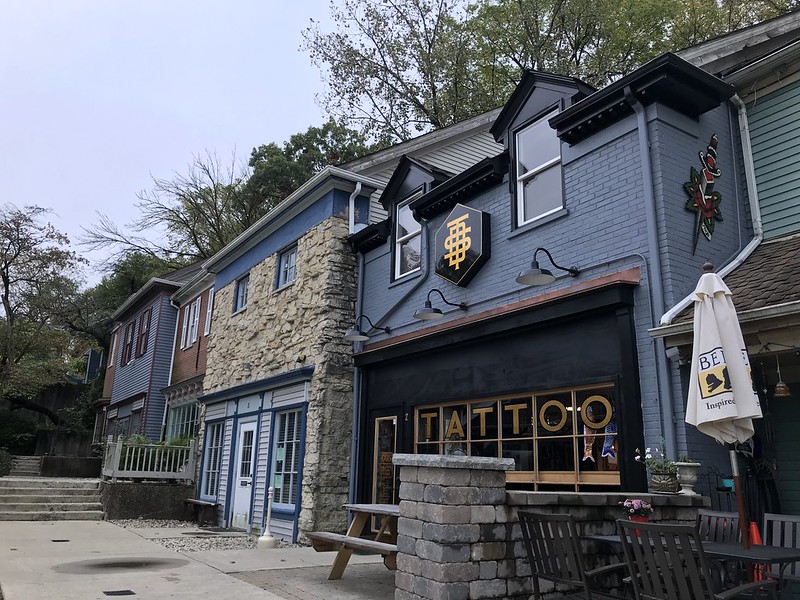
The chili and panini were great on a grim, gray day, but the slot machines, while not in use, detracted from the charm. They seem to be a big thing in the southern and southwestern suburbs.
And so back to Camp Bullfrog Lake, where we bought a bundle of wood for $5. Again it took a while to get a fire going, then it had to be resuscitated several times. Next door outside Cabin 7. a horde of teenage girls was celebrating a birthday with a fire, song, and dance, and, as we saw the next morning, Silly String.


Alas, there were no breaks in the clouds this evening, and at about the time I had roasted my last marshmallow I started to see telltale flashes, soon followed by rumbling. Yes, just as I was confident the fire had finally taken hold in the wood, it began to pour.
From inside, however, we watched the fire burn survive a few outright downpours in addition to the steady rain for at least another 30 to 45 minutes. It didn’t just smolder and throw sparks. It flamed. Perhaps it did better for lack of our nurturing attentions, aka interference.

October 8, 2018

For breakfast we sent to Spring Forest 2, which had been closed the evening before. Like Jen’s Guesthouse, the Irish Legend, and Ashbary Coffee House, Spring Forest 2 is on a stretch of Archer Avenue, but on the opposite side. While the breakfast menu is very limited, a $2.50 breakfast burrito was just the thing. We ate on the porch, where the seats and tables were dry, but behind the house is a descending series of garden seating. Even wet from the overnight rain, it’s an interesting, charming setup. I love the multiple levels and again couldn’t do them justice in photos.
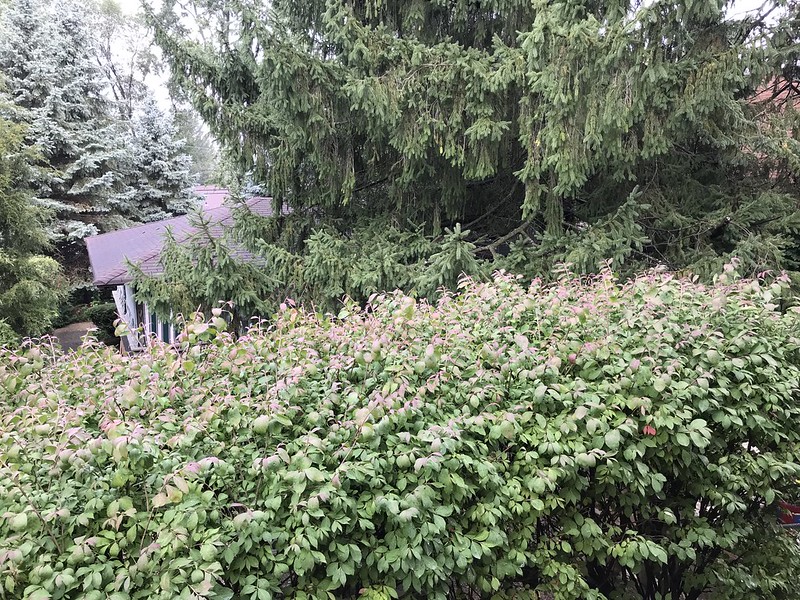


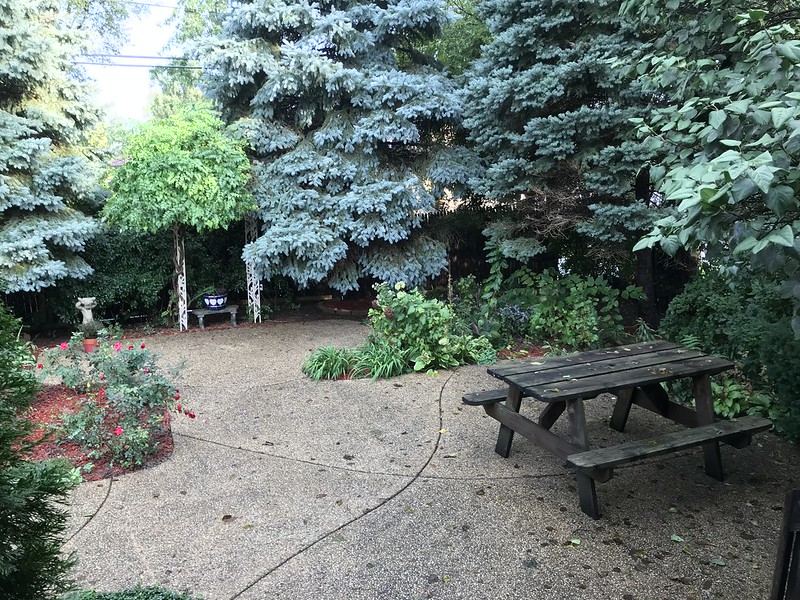

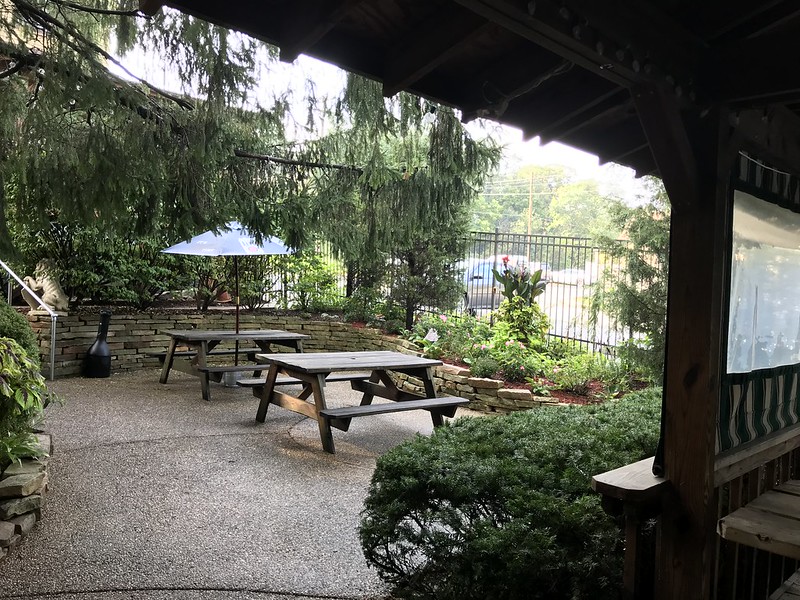
We stopped at Ashbary House, which wasn’t open, so we went to Kirsten’s Danish Bakery for coffee and something pumpkin.






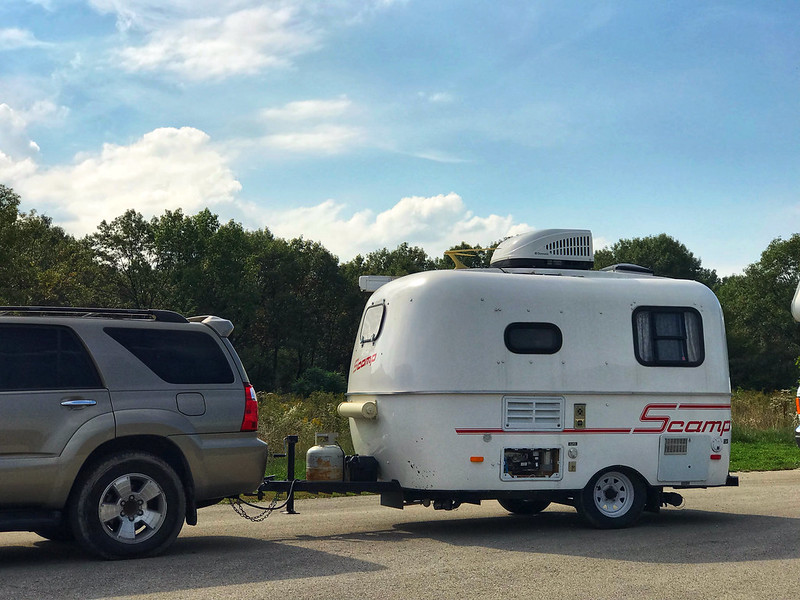
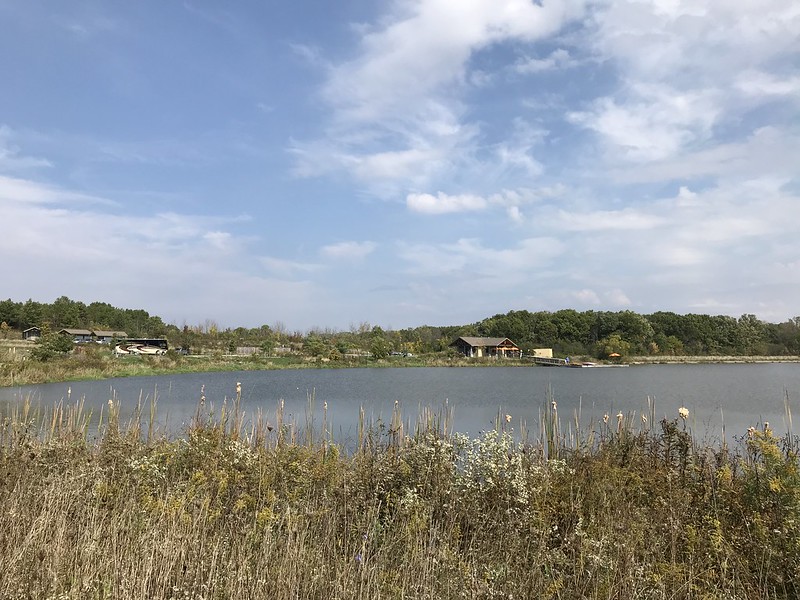
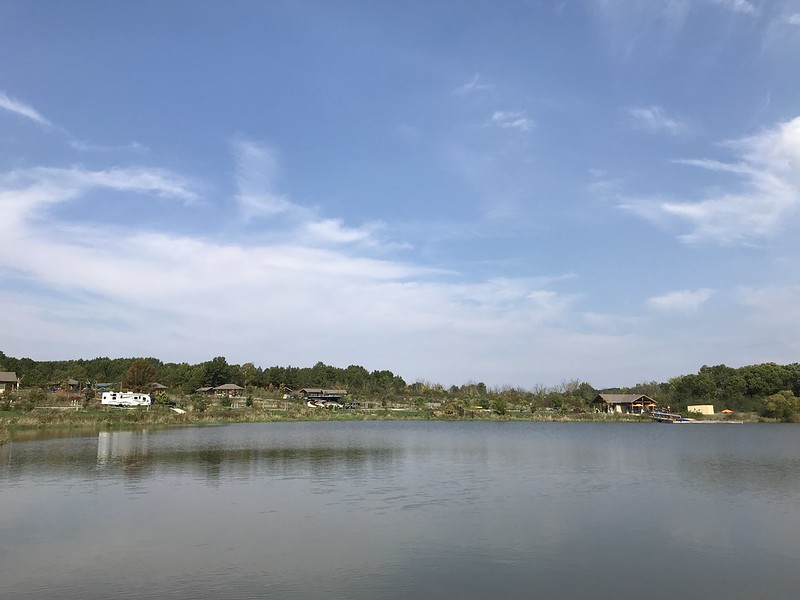
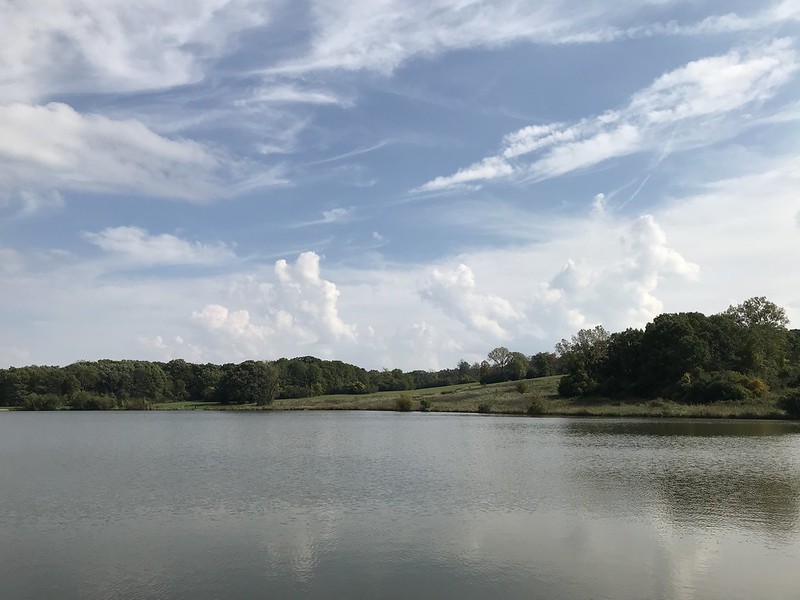

Having fueled ourselves, we turned to Black Partridge Woods on Bluff Road, a gem of a nature preserve with a lively stream bubbling underneath a stone arch bridge. Here, bluebells bloom among the trees in spring. It would be idyllic — except someone decided to run an extension of I-355 over Bluff Road about a quarter mile away. It’s hard to appreciate the bubbling of the brook over the near-constant roar of the interstate. Bluff Road is hilly, twisty, and rustic away from its intersections. Now at one intersection a massive concrete warehouse-style building is materializing across from what may have been once peaceful houses on a country lane. I should be content that Black Partridge Woods with its spring-fed stream hasn’t been paved over.


Next we headed to nearby Waterfall Glen, named for Seymour “Bud” Waterfall, not for the picturesque CCC-built low-head dam on Sawmill Creek. Waterfall Glen surrounds Argonne National Laboratory, and it usually takes me a while to figure out I have to search for “Rocky Glen Trail” to get to the right parking area. Otherwise I find myself trying not to look guilty at one of Argonne’s guard houses as I did now.
After Google helpfully suggested “Rocky Glen,” we found ourselves on familiar ground—a roadway closed off to cars, a left-hand turn on a trail, then a walk along Sawmill Creek to the low dam. There often seems to be hordes of people here, including this day. I’d forgotten that it was a school holiday, Columbus Day, so there were lots of people milling about and walking in the water.
I’d read that a trail runs along the creek and thought I’d seen it, so we started down its muddy spots. It passes through trees for a short distance before it opens onto a length of even stepping stones below a shored-up hillside. At the point where the creek turns south, you see the dam in one direction and a part of the creek you can imagine to be somewhat wild in the other. I could have stayed there all day if my body would let me. For a short time we were the only people around, but soon people and pets started to appear — almost like we’d been followed.
I think I could be happy living near a stream like the one at Black Partridge Woods or Sawmill Creek at Waterfall Glen — as long as no one thought to build an interstate extension or highway or concrete block nearby.
Our next stop was another favorite, the Plush Horse in Palos Park, a “venerable ice cream shop” in a house located in an area that seems more developed than I remember. Sigh. The inside was raucous with children and teenagers, so I sought refuge outside on a comfy Adirondack chair that made eating an ice cream cone a challenge, accompanied by yellow jackets — it’s that time of year. Not content with buzzing us, one decided to take a long stroll on my mouth, where its little feet tickled my lips and the threat of its stinger ensured I would do nothing about it. It’s amazing how long a minute or two can seem.
After dessert at the Plush Horse, I found Mediterranean cuisine at a new place, Simple Taste, in a fading strip shopping center. We were the only diners in the late afternoon/early evening hours. I had baba ghanoush and zucchini noodles — both of which hit the spot not taken up by Plush Horse ice cream.
And so another camping adventure ends, with a full heart and belly.
Lake Calumet: A vision for bringing back life
25 March 2018
J. and I headed to the Calumet area, specifically Deadstick Pond near Lake Calumet. There’s no public access I can see, and a fence separates the area around Lake Calumet from the frontage road parallel to I-94, Doty Avenue. Collected against the fence is trash — tons of trash. I envision hordes of high school students and adult volunteers spending a few hours a few weekends cleaning up the accumulated trash along the fences at Lake Calumet and Deadstick Pond. The area seems so little traveled that no one may notice, but it’d be a small step toward restoring a semblance of beauty to the area — as long as it isn’t trashed again.
The Calumet area, for many years the center of Chicago’s steel industry, carries an eerie air of a transition zone. Stony Island, a broad, heavily traveled avenue through Hyde Park, South Shore, and other communities, turns into a two-lane, potholed, unmaintained road flanked by tall grasses, nascent parks like Big Marsh, landfills, and the occasional industrial-style building and parking lot. There’s not a house to be seen, nor any sign of a neighborhood.
Eventually, the avenue that further north boasts restaurants, stores, churches, hospitals, and other urban fixtures dwindles down to a cracked, littered pavement that ends abruptly short of a curve of the Calumet River. Traveling down Stony Island can feel like a ride on a time machine toward a future apocalypse, when industry’s mark is visible but faded, and nature is slowly creeping back through the piles of plastic bags and bottles. It’s like the end and beginning of the world.
As J. carefully navigated the potholes, a few cars and trucks sped past at speed — in a hurry to get to who knows where. We stopped on the roadside at Deadstick Pond and peered through the vegetation and fence for a peek at some ducks bobbing along among gray snags. There may have been swans, or plastic bags masquerading as swans.
Next we found Hegewisch Marsh, where he parked by the rail bridge and we wandered down a rough road parallel to the tracks. Many ducks floated on the open water while their passerine counterparts flitted about the bare trees. Along the way I found a lot of scat, most loaded with fur. The open areas connected by the river, rail lines, streets and bridges, along with wildlife-rich marshes, must be coyote havens. I hoped one was following us with its amber eyes as we tread on its territory.
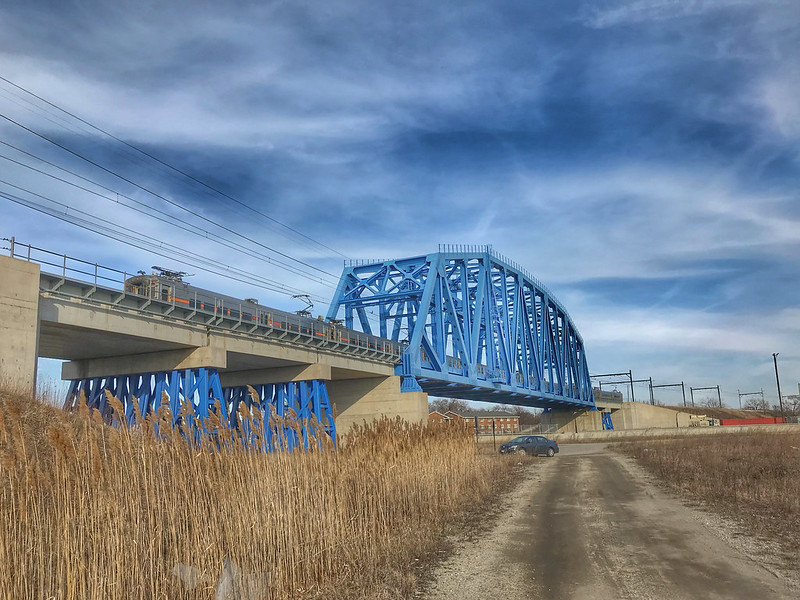


We stopped at Flatfoot Lake in Beaubien Woods, also off I-94, which roars over the otherwise serene setting.


On a satellite map, Lake Calumet, the largest lake within Chicago, looks artificial. I couldn’t guess its original contours. It’s surrounded by nearly empty, decaying streets, the occasional vast building, the ceaseless noise of a busy interstate, and other trappings of modern dreams. There are other dreams, though. The Lake Calumet Vision Committee has a dream for the Calumet region that includes biking, jogging, paddling, and sailing, along with a trail connecting the Pullman National Monument to the young Big Marsh Park — potentially 500 acres of new habitat. It’s going to take time, and it can’t happen fast enough for me.
Now if we could only do something about the roar of I-94.
Source: Raising Parks and Wetlands from Industrial Sites along Lake Calumet
Watch out for wildlife, hazards, and polite requests (signs of the times)
I don’t see signs about wildlife very often, although this one at Windigo, Isle Royale National Park, warns unsuspecting visitors about the island’s less famous, thieving canine. What do the red foxes of Isle Royale do with the car keys and hiking boots they purloin?
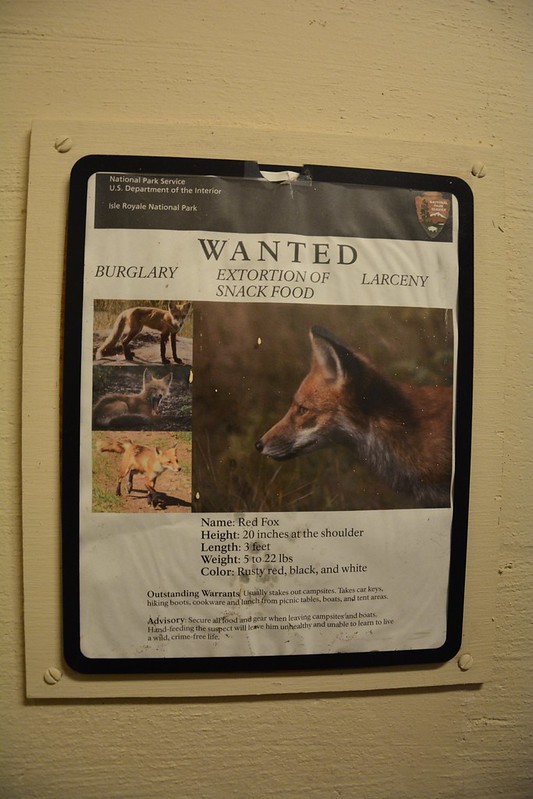
This sign, at Hidden Lake Forest Preserve near Morton Arboretum, exhorts you not to panic if Wild Fido follows you. He’s simply giving you an escort through his domain. If this task makes him snappish, simply throw clumps of dirt at the ground by his feet. I’m having visions of Monty Python and “Confuse-A-Cat.”
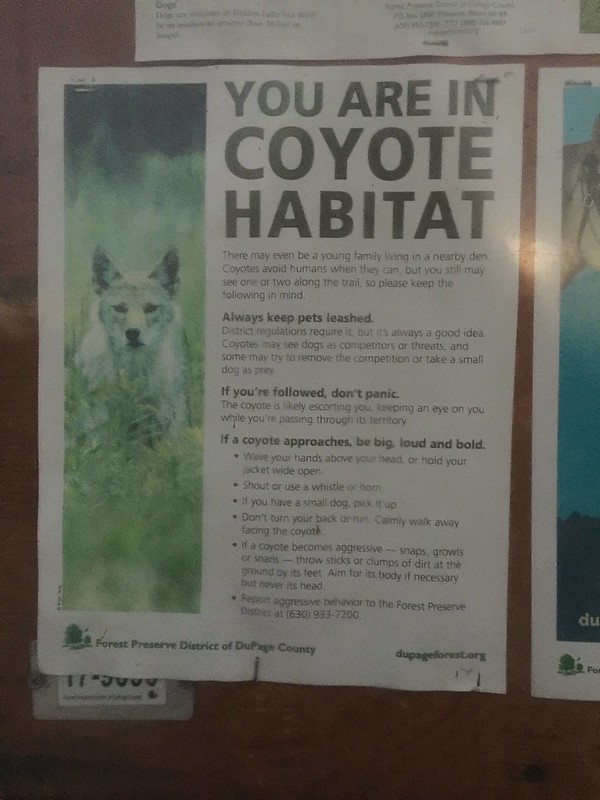
Other signs warn you about smaller wildlife, especially the kind that hops aboard. This one, at Michigan’s Grand Mère State Park, tells what to wear to help stave off the dreaded tick. By the time you’re at the park, however, you may not have clothing alternatives handy. The tick shown is terrifyingly big, but the ticks that can share Lyme disease with you may be little larger than a pinhead.
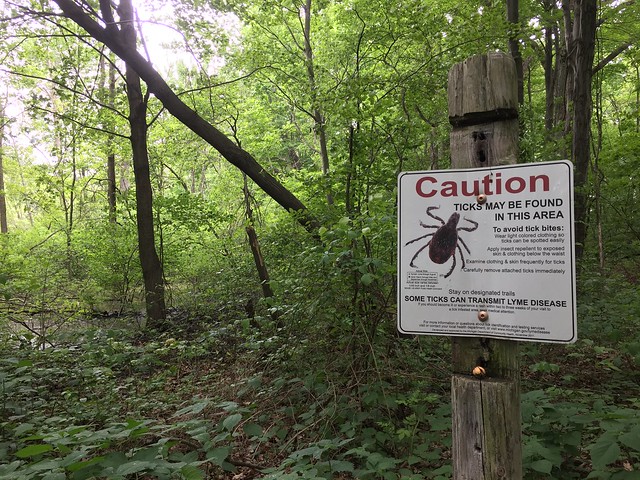
Pro tip: At Shawnee National Forest, which is tick heaven, I thought wearing a hat would keep them off my head at least. Not so. After a delightful morning at Pomona Natural Bridge, I felt movement in my hair and found a couple strutting under my hat on top of my scalp. This is one of those times when baldness would be an advantage.
Located at a town park near Grand Mère, this sign is not so much a warning as a caution. If you aren’t careful and you spread the emerald ash borer, this will happen to your ash trees. I can attest to the lethal behavior of the well-named emerald ash borer—both tall, mature trees in front of The Flamingo, plus the mature tree that shaded my bedroom at 55th and Dorchester, succumbed to these little green scourges.
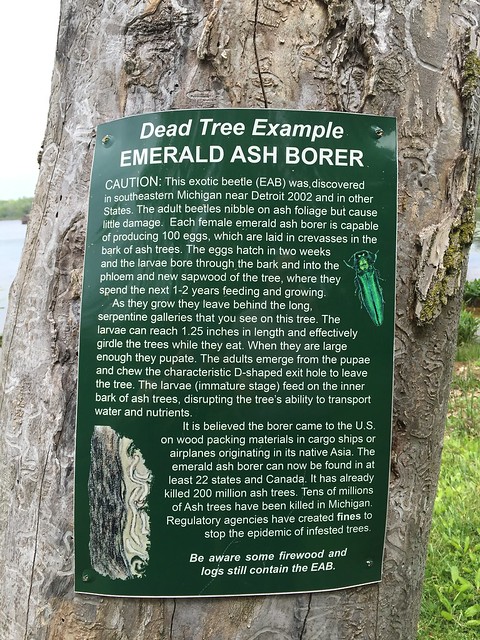
At Hidden Lake Forest Preserve, we’re told it’s too late to keep out another horror, the dreaded zebra mussel. You can be a hero, however, by cleaning your boat and equipment properly so you don’t transplant them to a body of water where they haven’t taken hold. The use of “infest” is a great touch. It reinforces the nearby “No swimming” sign nicely. Swimming in infested waters just doesn’t appeal to me, even if I could swim.

If you’re about my age, you recall that “only you can prevent forest fires (that aren’t caused by lightning strikes, volcanoes, and other natural hazards). Many parks post the current risk of wildfire danger based on conditions like drought and wind. At Lyman Run State Park in the Pennsylvania Wilds, Smokey Bear can’t seem to make up his mind.
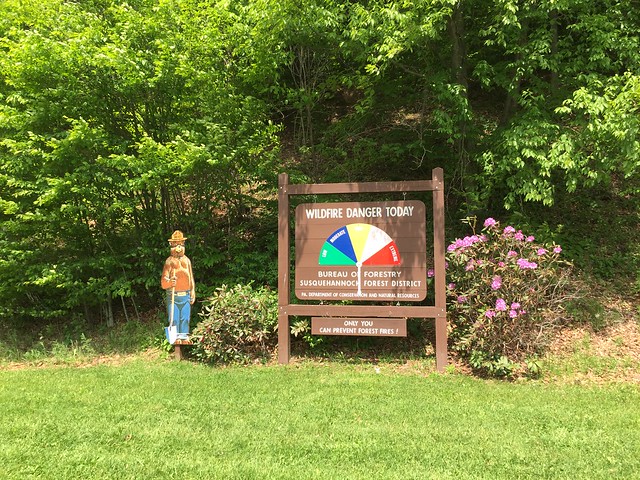
This version of Smokey opted for words instead of visuals, which makes his message less ambiguous (no broken pointer). No doubt that snow on the ground helps to keep risk low.
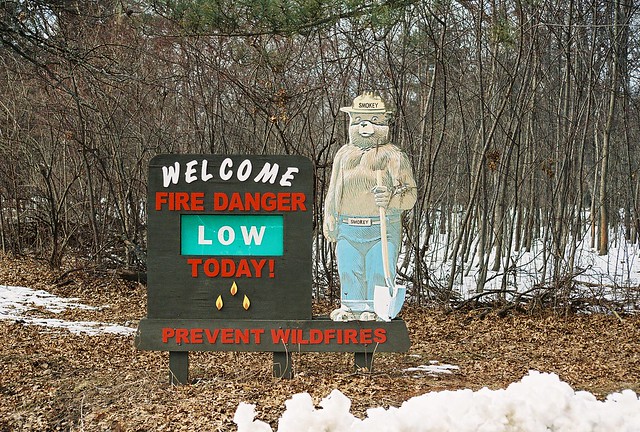
Taking shape on Stony Island Avenue in the remnant heart of Chicago’s steel industry, Big Marsh Park features a bike park (built on slag too expensive to remove), natural areas, and occasional bald eagle sightings. An enticing hill nearby forms a lovely backdrop for a walk at Big Marsh, which is still in its infancy. When you get closer, however, and read the signs, you learn it’s a steaming, seething landfill that’s being “remediated.” There’s no happily running up and down this slope. How I miss the Industrial Revolution.
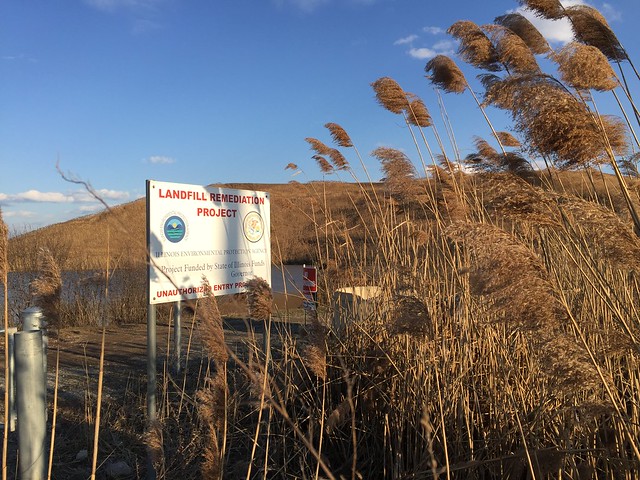
It’s not every day you’re warned about lurking unexploded bombs, but for me this was no ordinary day. It was my first visit to Old Fort Niagara in nearly 40 years, which coincided with Memorial Day weekend. Most of the time, the fort is manned by soldiers in 1700s military fashions, but in honor of the holiday other conflicts were represented. I kept my distance from the bomb. Just in case.
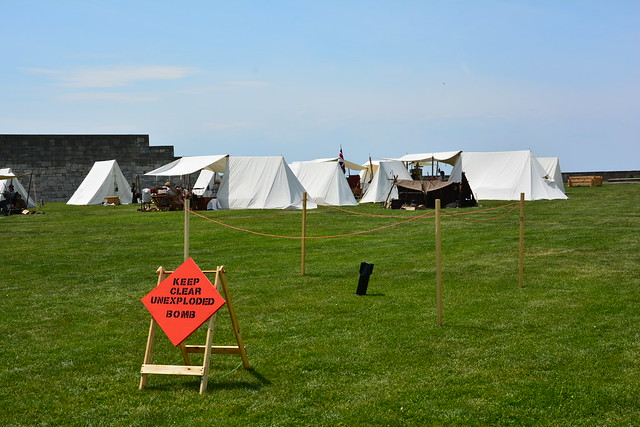
This is one of the odder warning signs I’ve seen. I left the chef alone—after all, he works with sharp objects.
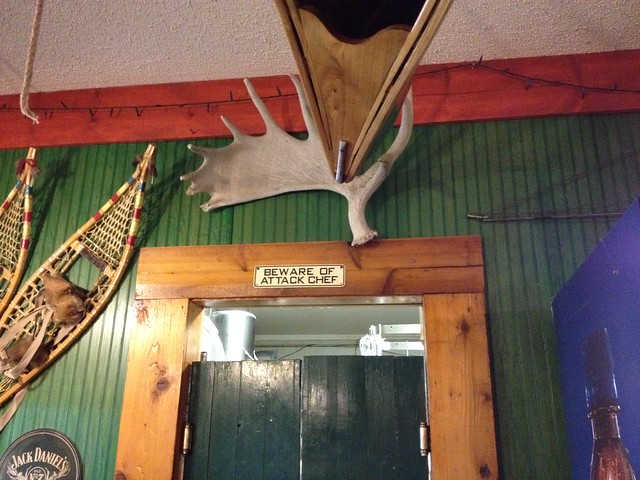
Slow down. Chicago is under a budget crunch, but do they send out a lone fireman like this? A lone fireman without a steering wheel? Or arms?

Here’s a warning sign you can ignore. It’s outside Riley’s Railhouse, a train car bed and breakfast in Chesterton, Indiana, that’s a treasure trove of signs.

From the exterior of the car I slept in:
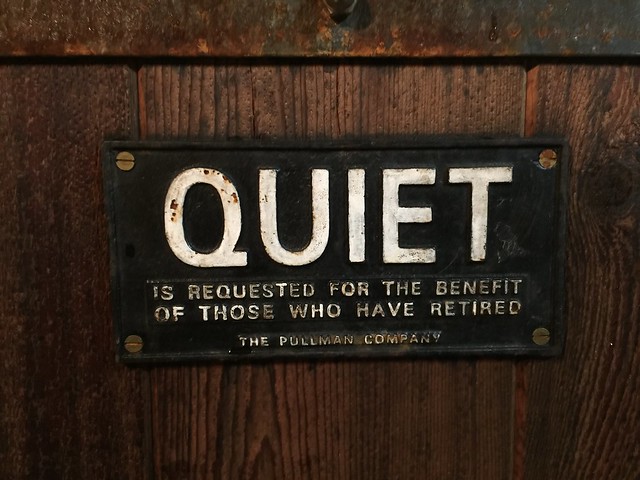
At Indiana Dunes National Lakeshore’s West Beach, it looks like the National Park Service is testing which sign or message is most effective at keeping visitors off the dunes. This one shows bare tootsies with the universal “No” slash, helpfully pointing out the dunes are ours.
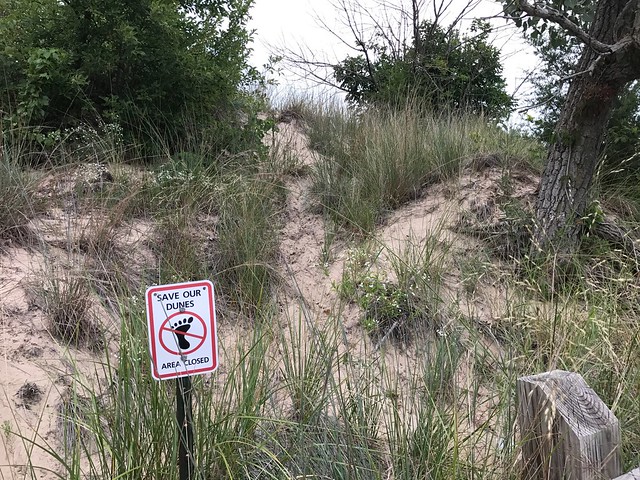
A less friendly, sterner, more wordy one admonishes you to “KEEP OFF THE DUNES” and appeals to your desire to “Please help protect and preserve our fragile dune systems!”
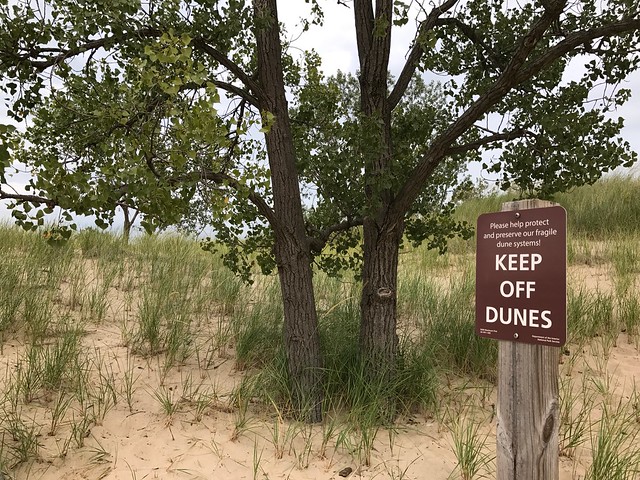
At the beach, this slash through a barely visible hiker shuns wordiness (or words) for directness and simplicity without justification or explanation.

It’s sandwiched between even more minimalistic signs with a slash, planted where the dunes start ascending. Don’t. Just don’t.
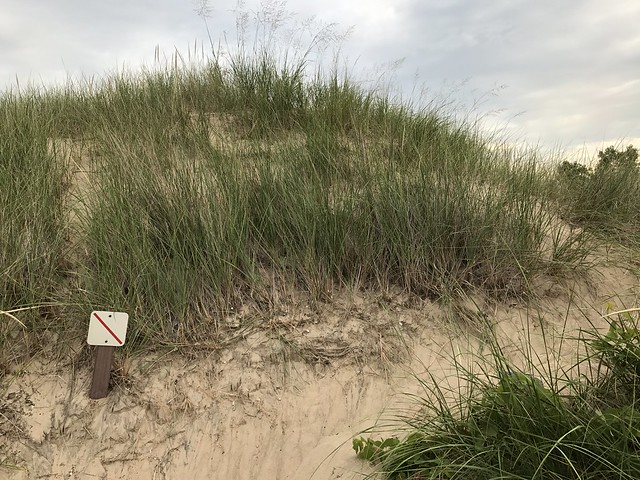
Years ago when a landfill near my cousin’s house became a Superfund site (just what you want in your backyard), it was surrounded by an electrified fence complete with warning signs. Noticing there were no insulators, I dared to touch it. In this case, however, I’m certain the area behind the fence is dangerous, and this is as far as I got.

Normal weathering or resentment over the weapons message?
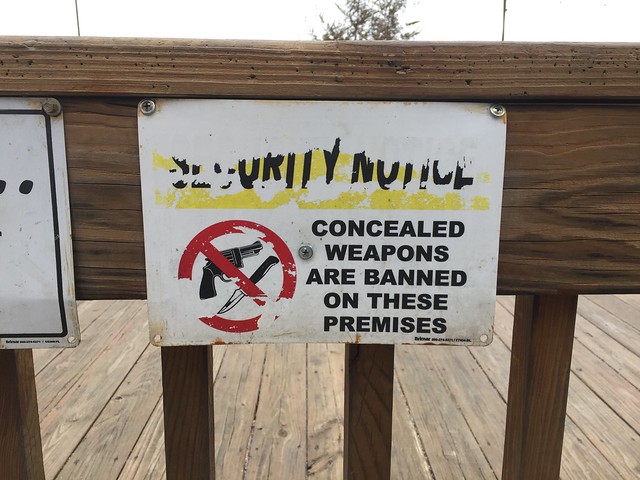
Waterfall Glen, a DuPage County Forest Preserve, forms a ring around Argonne National Laboratory, “born out of the University of Chicago’s work on the Manhattan Project in the 1940s.” Naturally, the immediate area around the lab is secured. While I was baffled by this sign about “lock installation” and “any unauthorized lock,” it was the 10 or so locks on the chain that got my attention. Why do people need to add locks to that chain? Why do they need authorization? From whom do they get authorization? Why are unauthorized locks removed? What does it all mean?

Remember when lead was thought to be safe? I don’t, either. This sign is on an old pump at the remnants of an old general store in the western part of Shawnee National Forest.

Warning: If you leave expensive stuff lying around, even at an exclusive university, it will walk off. You can bank on it.

RATS? There are RATS in Hyde Park?
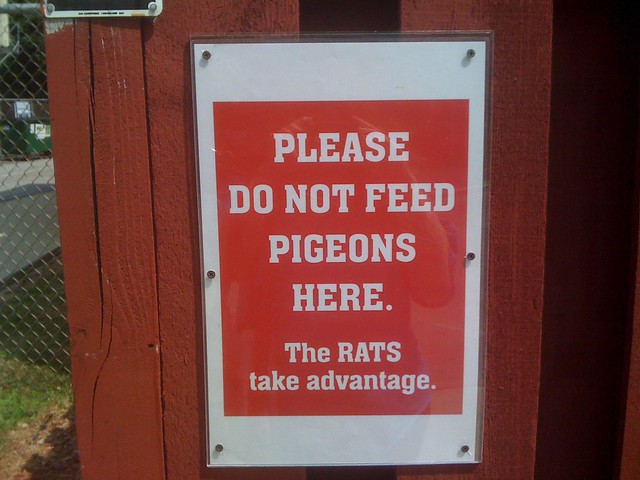
Sycamore leaves at Sand Ridge Nature Center in South Holland
Now that I know what they are, I’m finding sycamore leaves everywhere in parks and forest preserves. These beauties are from Sand Ridge Nature Center in South Holland, Illinois. Although they’re turning brittle, they look like shiny leather.
